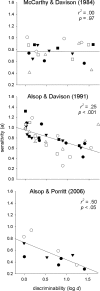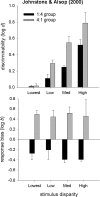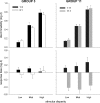Stimulus disparity and punisher control of human signal-detection performance
- PMID: 20885810
- PMCID: PMC2832343
- DOI: 10.1901/jeab.2010.93-185
Stimulus disparity and punisher control of human signal-detection performance
Abstract
The present experiment examined the effects of varying stimulus disparity and relative punisher frequencies on signal detection by humans. Participants were placed into one of two groups. Group 3 participants were presented with 1:3 and 3:1 punisher frequency ratios, while Group 11 participants were presented with 1:11 and 11:1 punisher frequency ratios. For both groups, stimulus disparity was varied across three levels (low, medium, high) for each punisher ratio. In all conditions, correct responses were intermittently reinforced (1:1 reinforcer frequency ratio). Participants were mostly biased away from the more punished alternative, with more extreme response biases found for Group 11 participants compared to Group 3. For both groups, estimates of discriminability increased systematically across the three disparity levels and were unaffected by the punisher ratios. Likewise, estimates of response bias and sensitivity to the punisher ratios were unaffected by changes in discriminability, supporting the assumption of parameter invariance in the Davison and Tustin (1978) model of signal detection. Overall, the present experiment found no relation between stimulus control and punisher control, and provided further evidence for similar but opposite effects of punishers to reinforcers in signal-detection procedures.
Keywords: human; mouse-click; point-loss; punishment; response bias; signal detection; stimulus disparity.
Figures





Similar articles
-
Effects of point-loss punishers on human signal-detection performance.J Exp Anal Behav. 2009 Jul;92(1):17-39. doi: 10.1901/jeab.2009.92-17. J Exp Anal Behav. 2009. PMID: 20119520 Free PMC article.
-
Reinforcer control and human signal-detection performance.J Exp Anal Behav. 2000 May;73(3):275-90. doi: 10.1901/jeab.2000.73-275. J Exp Anal Behav. 2000. PMID: 10866352 Free PMC article. Clinical Trial.
-
Rapid acquisition of bias in signal detection: dynamics of effective reinforcement allocation.J Exp Anal Behav. 2012 Jan;97(1):29-49. doi: 10.1901/jeab.2012.97-29. J Exp Anal Behav. 2012. PMID: 22287803 Free PMC article.
-
A model for discriminating reinforcers in time and space.Behav Processes. 2016 Jun;127:62-73. doi: 10.1016/j.beproc.2016.03.010. Epub 2016 Mar 22. Behav Processes. 2016. PMID: 27016156 Review.
-
Stimulus Avoidance Assessment: A Systematic Literature Review.Perspect Behav Sci. 2024 Feb 26;47(1):139-166. doi: 10.1007/s40614-024-00398-1. eCollection 2024 Mar. Perspect Behav Sci. 2024. PMID: 38660499 Free PMC article. Review.
Cited by
-
Stimulus Control Research and Practice: Considerations of Stimulus Disparity and Salience for Discrimination Training.Behav Anal Pract. 2021 Jan 29;14(1):272-282. doi: 10.1007/s40617-020-00509-9. eCollection 2021 Mar. Behav Anal Pract. 2021. PMID: 33732597 Free PMC article. Review.
References
Publication types
MeSH terms
LinkOut - more resources
Full Text Sources

